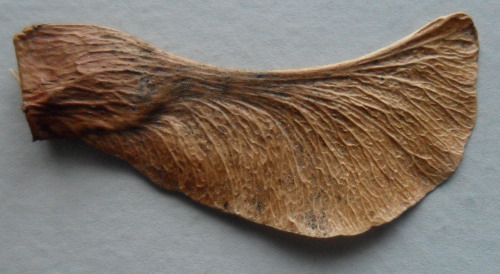
Inspiration from Spinning Maple Seeds
Looking to nature for inspiration (biomimicry) is nothing new. I've already covered turbine blades inspired by humpback whale fins and drag-reducing textures that mimic shark skin, so next up we have the elegant spinning maple seed.
 CFD Simulation of a Spinning Maple SeedLeading edge vortex shown by streamlines
CFD Simulation of a Spinning Maple SeedLeading edge vortex shown by streamlines
Seed Aerodynamics
Known by many names, including samaras, spinning jennies, and whirlybirds (any more?), these marvels of aerodynamics disperse seeds far and wide in an attempt to maximize the chances of landing on fertile ground away from the parent tree. The seed has a mono-wing weighted such that it spins in a smooth motion and generates lift, prolonging its flight and increasing its chances of being carried to pastures new by a gust of wind.
 Maple Seed
Maple Seed
Lift is generated by a vortex that separates from the seed's leading edge and sits just above the wing's top surface. Interestingly this lift mechanism is also employed by insects and bats.
Applications
Given the rapid evolution of flying technology it was only a matter of time before researchers began to explore the maple seed's mono-wing as an alternative to traditional flying machines:
- At the University of Queensland Robotics Design Lab researchers combined an inexpensive sensor and a mono-wing for a widely dispersed environmental sensor array called Samara.
- Lockheed Martin combined a mono-wing with a propeller in a 30 cm drone called the Samarai. It can take off, maneuver, and land using a sophisticated control system, with the aim of performing surveillance operations.
Lockheed Samarai
Notes
- Maple seed aerodynamics explained: Video: Maple Seeds Ride Self-Generated Tornadoes
- Samara: Steerable paper planes and maple seeds the basis for life-saving, disposable UAVS
- Samarai: Lockheed Martin's Samarai monocopter - you won't believe how this thing flies
- The maple seed geometry for the CFD simulation was created in Caedium Professional. The CFD simulation was performed using the incompressible, steady-state RANS solver, with a Moving Reference Frame (MRF), and the k-omega SST turbulence model.
- Richard Smith's blog
- Login to post comments
Select Language
Recent blog posts
- CFD Simulates Distant Past
- Background on the Caedium v6.0 Release
- Long-Necked Dinosaurs Succumb To CFD
- CFD Provides Insight Into Mystery Fossils
- Wind Turbine Design According to Insects
- Runners Discover Drafting
- Wind Tunnel and CFD Reveal Best Cycling Tuck
- Active Aerodynamics on the Lamborghini Huracán Performante
- Fluidic Logic
- Stonehenge Vortex Revealed as April Fools' Day Distortion Field

